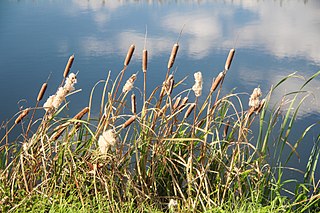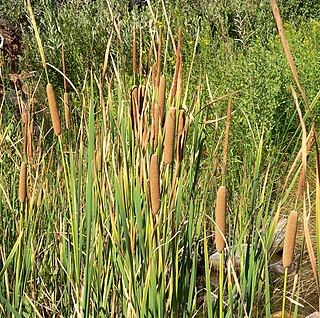
Typha is a genus of about 30 species of monocotyledonous flowering plants in the family Typhaceae. These plants have a variety of common names, in British English as bulrush or reedmace, in American English as reed, cattail,or punks, in Australia as cumbungi or bulrush, in Canada as bulrush or cattail, and in New Zealand as raupo. Other taxa of plants may be known as bulrush, including some sedges in Scirpus and related genera.

Typha latifolia is a perennial herbaceous plant in the genus Typha. It is found as a native plant species in North and South America, Eurasia, and Africa.

Herdsman Lake, also known as Herdsmans Lake, is a freshwater lake located on the Swan Coastal Plain, 6 kilometres (3.7 mi) north-west of Perth, Western Australia, in the suburb of Herdsman. The main shared use path around the lake is approximately 8 kilometres in length, whilst the wetland perimeter of the lake is approximately 7.5 kilometres.

Typha angustifolia L. is a perennial herbaceous plant of genus Typha. This cattail is an "obligate wetland" species that is commonly found in the northern hemisphere in brackish locations.

Bolboschoenus fluviatilis, the river bulrush, is a species of flowering plant in the sedge family, Cyperaceae. Its range includes Australia, New Zealand, New Caledonia, Canada, the United States, and northeastern Mexico. B. fluviatilis and its fruits are important as food sources for waterfowl such as geese, ducks, bitterns, and swans. It also provides cover and nesting sites for these and other species of birds, as well as small mammals. Like other Bolboschoenus species, B. fluviatilis has strong tubers and rhizomes which help to stabilize intertidal habitats by preventing erosion.

Calamotropha paludella is a species of moth of the family Crambidae. It is found in Europe, Africa, Australia and large parts of Asia.

Typha domingensis, known commonly as southern cattail or cumbungi, is a perennial herbaceous plant of the genus Typha.
The Forrestdale and Thomsons Lakes Ramsar Site comprises two separate nature reserves, totalling 754 ha in area, protecting two shallow fresh to brackish, seasonal lakes in a suburban and agricultural landscape in south-western Western Australia. It lies in the Swan Coastal Plain bioregion and is used mainly for birdwatching and walking. The site is recognised as being of international importance under the Ramsar Convention on Wetlands, under which it was designated Ramsar Site 481 on 7 June 1990.

Woggabaliri is a traditional Indigenous Australian "co-operative kicking volley game".
Gibbovalva tricuneatella is a moth of the family Gracillariidae. It is known from the states of New South Wales and Queensland in Australia and the Ryukyu Islands of Japan.

The shy cosmet moth is a moth of the family Cosmopterigidae. It is known from all of Europe, as well as Asia, Australia and New Zealand. It is also present in North America, where it is distributed from Nova Scotia to Virginia, west to Oklahoma and north to Ontario. The habitat consists of fens and marshes.

Typha orientalis, commonly known as bulrush, cumbungi, or raupō, is a perennial herbaceous plant in the genus Typha. It is native to Australia, New Zealand, Malaysia, Indonesia, Japan, Korea, Mongolia, Myanmar, Philippines, China and the Russian Far East.
Scieropepla ceramochroa is a moth of the family Oecophoridae. It was described by Turner in 1919. It is found in Queensland.
Scieropepla obfuscata is a moth of the family Oecophoridae. It was described by Edward Meyrick in 1921. It is found in Queensland, Australia.
Scieropepla trinervis is a moth of the family Oecophoridae. It was described by Edward Meyrick in 1904. It is found in the Australian states of New South Wales, Queensland, South Australia and Victoria.

Bulrush is a vernacular name for several large wetland grass-like plants
Currency Creek Game Reserve is a protected area in the Australian state of South Australia located on the south-western side of Lake Alexandrina in the gazetted localities of Currency Creek and Goolwa North about 0.5 kilometres north-east of Goolwa.
Scieropepla is a genus of moths in the family Oecophoridae.
Yimbun is a rural locality in the Somerset Region, Queensland, Australia. In the 2016 census Yimbun had a population of 33 people.

Alma Theodora Lee was an Australian botanist and plant taxonomist who worked at the National Herbarium of New South Wales, University of Sydney, and CSIRO. She is notable for raising the standard of systematic botany in Australia, and for her revisions of Swainsona and Typha. She also studied the Fabaceae with colleagues. The standard author abbreviation A.T.Lee is used to indicate this person as the author when citing a botanical name. She described over 40 species. The March 1991 issue of the journal Telopea was dedicated to her memory.












